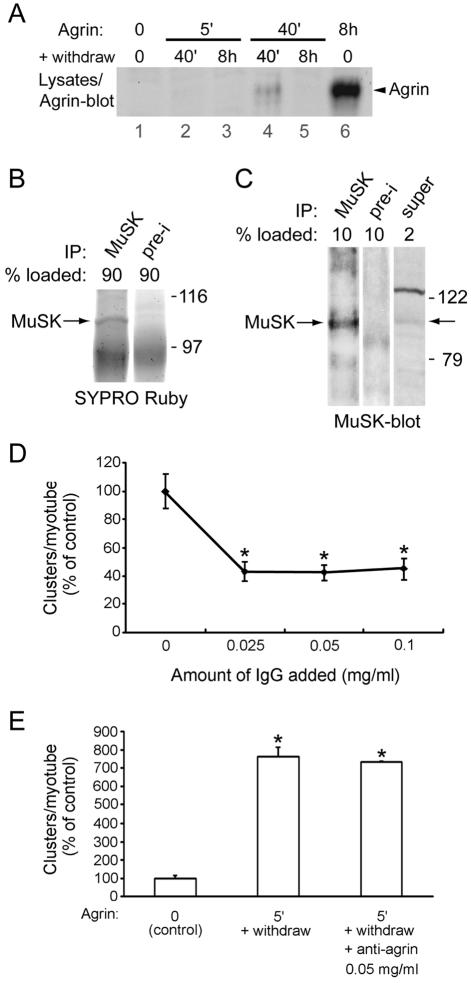FIG. 8.
Little, if any, agrin remains cell bound after a brief agrin pulse and is not responsible for clustering. (A) C2 myotubes were pulse treated with agrin (0.5 nM for 5 or 40 min), followed by washing and withdrawal for 40 min or 8 h; parallel samples were treated continuously with agrin for 8 h. Cell lysates were analyzed by agrin immunoblotting. No agrin signal of ca. 120 kDa (representing recombinant agrin, C-Ag12,4,8) is detectable in cells treated for 5 or 40 min followed by 8 h of withdrawal (lanes 3 and 5). A small agrin signal is visible in cells treated for 40 min followed by a 40-min withdrawal (lane 4), but this does not correlate with clustering, which is the same after a 5- or 40-min pulse (see Fig. 7). (B) MuSK was immunoprecipitated (IP) from C2 lysates, and 90% of the precipitate was analyzed by SDS-PAGE and SYPRO Ruby protein staining. MuSK was identified based on its molecular weight and its absence in preimmune (pre-i) control precipitation. Using a parallel BSA standard (data not shown), the amount of precipitated MuSK was determined in the gel (100 ng). (C) From the same samples as those used for panel B, 10% of the MuSK precipitate and 2% of the supernatant were analyzed by MuSK immunoblotting. By densitometric scanning, the efficiency of the immunoprecipitation was calculated (60%). (D) In the presence or ab-sence of different concentrations of anti-agrin antibody mAb33, C2 myotubes were treated for 6 h with agrin and AChR clustering was quantified as described for Fig. 5. An asterisk indicates that the result differs significantly from that for the control (no immunoglobulin G [IgG]; P < 0.001; two-tailed paired t test). (E) Myotubes were treated with 0.5 nM agrin for 5 min, followed by withdrawal of agrin, washing, and incubation in agrin-free medium in the presence or absence of 0.05 mg of mAb33/ml. After 8 h, AChRs were stained with rhodamine-α-BT and quantitated as described in the legend to Fig. 5. An asterisk indicates that the result differs significantly from that for the control (P < 0.001) but not from each other (P > 0.09; two-tailed paired t test).

